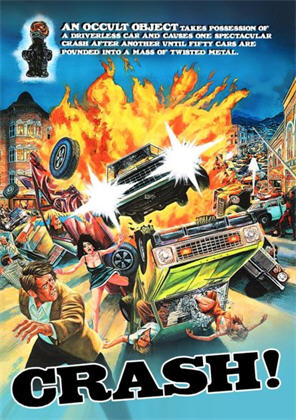
“Akasa’s of Hittite origin; a deity closely associated with Mars, the red planet… He’s an unpleasant character dedicated to vengeance, hatred and violence.”
Director: Charles Band
Starring: José Ferrer, Sue Lyon, John Ericson, Leslie Parrish, John Carradine, Jerome Guardino, Paul Dubov, Reggie Nalder
Screenplay: Marc Marais
Synopsis: Though it has no driver, a black convertible cruises the backroads of California near the town of San Cecilia, leaving mayhem and death in its wake… Kim Denne (Sue Lyons) wanders amongst the stalls of a swap-meet, finally haggling for possession of a strange artefact which she thinks her husband might like. At their home, however, the much-older Marc (José Ferrer) is watching home movies of himself and Kim playing tennis, and brooding over the accident that left him in a wheelchair. When Kim arrives, he questions her suspiciously about her movements, rejecting her gift of the artefact and forbidding her to leave the house—which has the effect of making her leave again immediately. As she goes, she shruggingly slips the artefact onto the loop in her key-chain… As Kim drives along the winding roads leading away from her husband’s property, a Doberman runs down the hillside and finally leaps into her car, attacking her. As she struggles to defend herself, the car skids off the road and crashes: the dog is thrown free, while the seriously injured Kim retains enough presence of mind to turn off the engine before losing consciousness… Some time later, having come to and dragged herself from the wreckage, Kim staggers to the side of the road, where she collapses as a car pulls up… At San Cecilia Hospital, plastic surgeon Dr Cross (Paul Dubov) describes the ongoing care necessary for the unidentified patient to her attendant, Dr Gregg Martin (John Ericson), and her nurse, Kathy Logan (Leslie Parrish); assuring them that in spite of the deep lacerations, there will be no permanent scarring if his instructions are followed. As Cross leaves, Kathy comments on the object that the patient is clutching; Martin observes that there is no reason to try and take it away from her until she regains consciousness. As Martin checks her drip, the patient begins murmuring, “Akasa, Akasa…” Dr Martin explains to Lt Pegler (Jerome Guardino) that the patient is still unresponsive; the detective tells him that so far, no-one has reported a missing woman, but he has an APB out for her car. Meanwhile, the Doberman has made it back to its master – Marc Denne – who praises it for disposing of Kim as he treats its injured leg. Later, however, Denne learns from a news broadcast that Kim is still alive, though as yet unidentified, and that she has amnesia. He drives to the hospital and manages to elude the staff while he searches for Kim’s room. There, he removes her oxygen line and pulls out her blood-transfusion drip before slipping away. However, quick action by Kathy Logan saves Kim’s life. Lt Pegler and Dr Martin have already discussed whether Kim’s “accident” could have been an attempt on her life, and now they agree to keep quiet about her surviving this new attack. Having taken a sketch of the artefact, Martin consults anthropologist Dr Edwards (John Carradine), who tells him that it is a representation of Akasa, a Hittite god associated with violence and revenge; he promises to try and locate an expert who call tell him more. At the hospital, Kim sits up, gasping—her eyes glowing fiery red as she gazes at the artefact. She throws it across the room, where via magnetism it sticks to the frame of a wheelchair—which suddenly comes to life, damaging the equipment in the room as Kim thrashes violently from side to side…
Comments: It is an extremely common fault of low-budget film-making that the product rarely lives up to its advertising; but whatever other criticisms might be levelled at Crash! – and there’s no shortage of them – it must be admitted that the film offers an exceedingly rare instance of what’s on the label being exactly what’s in the box:
An occult object takes possession of a driverless car and causes one spectacular crash after another until fifty cars are pounded into a mass of twisted metal.


“Fifty” may be a slight exaggeration, but otherwise that’s an admirable summation of this bizarre compendium of seventies obsessions which marks the official directorial debut of Charles Band. (Band has disowned the earlier Last Foxtrot In Burbank, perhaps understandably.) Crash! unfolds in a manner which suggests that Hal Needham and William Peter Blatty got drunk together one night and decided to pitch a story idea, but the screenplay is by Marc Marais, the second and last of his writing career—perhaps also understandably. The film was shot over a handful of consecutive weekends late in 1976: a piece of timing that raises some interesting questions about its genesis. It is impossible to watch Crash! without thinking of the period’s other satanic vehicle film, The Car, which was released five months after Crash! in May of 1977; nor without suspecting that this is another instance of a piece of guerrilla film-making beating its studio-produced inspiration into cinemas.
The Car, however, despite its own limitations, is an altogether better constructed and far more coherent production than Crash!, which contains a staggering amount of padding—albeit that its own construction goes some way towards disguising the fact, at least until after the event. The film opens with a driverless black convertible cruising the backroads of California, and has the car reappear at intervals even as the rest of the story unfolds: sometimes causing accidents through its speed and recklessness, sometimes deliberately running other vehicles off the road; and it is not until we are about two-thirds of the way through the film that it becomes clear that none of this has happened yet; that we are watching a series of “flash-forwards”…which we get to watch all over again once we reach the proper point in the story-line.
This schema also makes the film impossible to synopsise accurately: hence I haven’t mentioned up above the numerous vehicular mayhem scenes which punctuate the rest of the action. I will, however, place them in order within this review—keeping in mind that “in order” and “correct” are two different things.

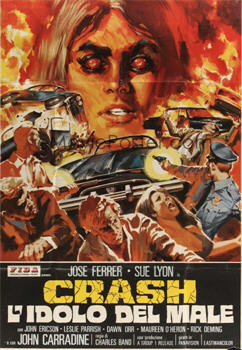
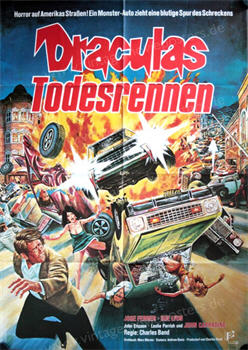
The reuse of the car interludes is by no means the only tactic that Charles Band employs to stretch out his tenuous narrative to an acceptable running-time—and the film opens with one of my favourites, offering a grainy, slow-motion glimpse of the car before fading to black…and holding that black-screen for a full twenty seconds before the credits start. These fade to an overly leisurely sequence in which a van carrying a young couple is run off the road by the car: an opening bit of action which again suggests that The Car was an influence here, mirroring as it does that film’s far more taut and chilling opening. After some unconvincing pushing and shoving, the van plunges over the shoulder of the road and down a slope, and taps against a tree—and offers the first instance of Crash!’s dominant motif, as the van erupts in a fiery explosion shown not once, but four or five times, from a variety of angles.
(I may say that I came away from a viewing of this film not frightened by its supernatural aspects so much as by the apparent state of American automobile manufacturing in the 70s…)
But while it is impossible not to laugh at the astonishing ease with which vehicles of all sorts erupt into fire-balls over the course of this film, it should in fairness be noted that the stunt-driving by which the “demonic” car is realised is well-executed and effective – not to mention insanely dangerous – with, I think, not a single glimpse offered of the hidden driver: a skilful touch which goes some way to selling the film’s absurd premise.
(The same cannot be said about the mannequins that substitute for the young couple as the van rolls down the hill, which flop about in an hilariously unconvincing manner.)
Through the rolling black smoke, we see a road sign indicating that the town of San Cecilia is some 38 miles away. This shot fades into one of Kim Denne wandering around a flea-market: a sequence which now acts as an interesting time-capsule, but which is otherwise unnecessary to the film except in respect of its length.
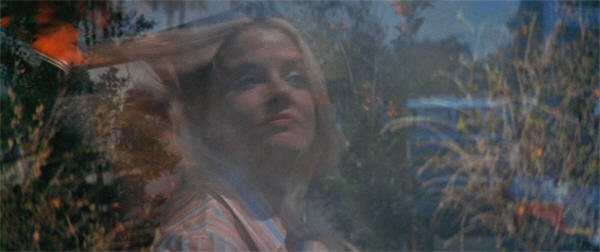
Charles Band was able to assemble a fairly impressive cast for this low-budget feature, although his efforts in this respect are somewhat undercut by a scenario that asks us to believe in José Ferrer and Sue Lyon as a married couple; granted, a miserable one. Nevertheless, after all her wanderings, Kim’s eye is caught by something which she thinks will interest her husband, a bizarre little figurine lying amongst the goods offered for sale by the equally bizarre Reggie Nalder. As she picks the figurine up, there is a distorted POV shot which suggests that it is looking back at Kim…
After some unconvincing haggling, Kim secures the object. As she walks away, the vendor gives her a look which might be a presage of horrors yet to come, or might just be, you know, Reggie Nalder.
The camera then follows Kim back to her car, which is – gasp! – a black convertible…
Kim drives off along the winding country roads that lead to the palatial home she shares with her husband, Marc (this might have been someone’s borrowed house, but the courtyard / parking area tends to suggest a motel). She does not rejoin her husband immediately, however, and he continues sitting in the dark, watching home-movies of himself and Kim playing tennis, before becoming overwhelmed by memories of the accident that left him in the wheelchair…
The relationship between Kim and Marc is presented in a curiously oblique way, which may have been intentional, or just the result of poor writing. Either way, the viewer is left uncertain whether this was ever a successful marriage, or whether Kim is just a “trophy wife” (an inference impossible not to draw, as things stand); whether Kim was responsible for the accident which injured her husband, as he seems to feel; whether she is indeed taking advantage of his incapacity to get up to “antics” (unspecified), or if this is just a morbid belief born of jealousy and brooding. This lack of clarity gives a strange edge to the conflict between them.
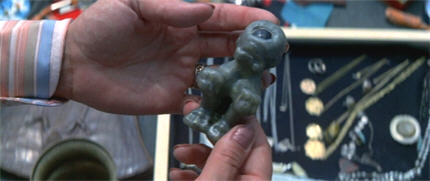
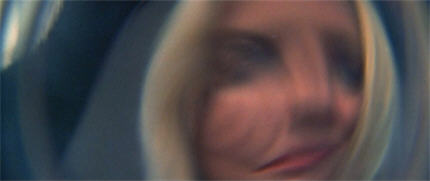
Kim tries to evade Marc’s bitter sniping by retreating into her sauna (plot-point!), and from here we fade back to the car, which nearly causes an accident as it speeds past a driver turning into the same road. The angered driver makes the mistake of pursuing it, and a push-and-shove ends with the second car skidding off the road, rolling over—and, yup, erupting into a fire-ball… This happens 32 miles from San Cecilia.
Marc follows Kim into the sauna for more sniping, and to reject her gift (we see at this point that he can stand up out of his chair with support, and walk a little), causing her to flee the house. She carries with her the figurine and, after contemplating it for a moment, attaches it to her key-ring via a loop on its back.
As Kim retraces her way over the narrow winding roads that connect her home to the highway, we suddenly see a Doberman racing down the same hillside. As she slows to round a corner, the dog leaps into the car and attacks her savagely. Struggling to defend herself, Kim loses control of her car, which crashes and rolls, and – gasp!! – doesn’t erupt in a fire-ball. The dog is thrown free and runs back up the hillside, while a bloodied Kim pulls herself free of the wreckage.
This sequence is hilarious for a number of different reasons. For one thing, if there was anything that film-goers in the 70s loved more than car crashes and possessions, it was surely Dobermans: a breed which during that decade dominated everything from killer-animal films to horror movies to comedy-thrillers; and the appearance of one in Crash!, already an outrageous exercise in pandering to trends, is amusingly inevitable. More broadly, however— I’m quite sure that this particular Doberman is the same one which also co-starred with José Ferrer in Zoltan, Hound Of Dracula, released in 1977, and directed by Albert Band; and I wouldn’t be surprised if this explained Ferrer’s appearance in Crash!: it isn’t hard to imagine Albert using his powers of persuasion to secure a name actor or two (and a talented dog) to help out his son’s official directorial debut. In fact, it isn’t out of the question that Ferrer and the dog worked on both films simultaneously, for Albert on weekdays and for Charles on the weekend.
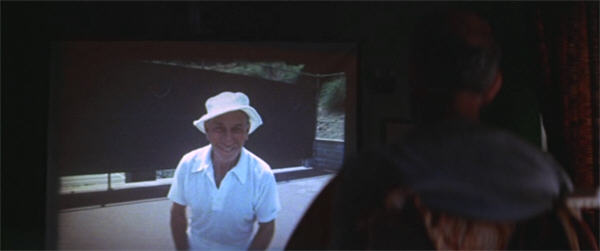
Meanwhile, in-film, this sequence offers two other delightful touches: one, the obvious fake dog-head puppet that attacks Kim – not the same one that appeared in Zoltan, and later in The Amityville Horror; the other, that the motorist who stops to help Kim when she collapses at the side of the road is played by Charles Band…
Kim ends up in San Cecilia County Hospital, where her facial and neck lacerations are treated by a plastic surgeon who leaves her in charge of Dr Gregg Martin (yes, yes: Doc Martin; get over it) and nurse Kathy Logan. Though her injuries are not life-threatening, she remains unresponsive; and, since she was carrying no ID, her carers do not know who she is—or why she is holding so tenaciously to the small figurine dangling from her key-ring. Nor do they understand what her mutterings of “Akasa” mean…
From here we cut back to the dog and its owner, who is – gasp! – Marc Denne, who praises it as he treats its injured hind leg. (When we watched the dog running away from the scene of the accident, it clearly had no such injury.) Here we learn that Kim’s “accident” was attempted murder—although how you would go about training a dog to run down a hillside, jump into a car and attack the driver remains a bit of a mystery. (Dobermans rock, though; and if any breed could do it, I’m sure that’s the one.)
A brief cut-back to the figurine gives way to another scene of the car cruising the roads. Its speed attracts a lurking cop, who chases after it—discovering like the driver before him that the convertible has no driver. He, too, tries to force it off the road, but only succeeds in losing control of his own vehicle, which rolls several times—but doesn’t erupt in a fire-ball. So that’s two, count ’em, two consecutive crashes with no fire-ball! Feh!
Back at the hospital, Kim’s situation has attracted the attention of the police. Lt Pegler reports to Dr Martin that no-one has reported a missing woman, nor has a crashed car been found. Martin tells him that Kim has said nothing to identify herself, merely repeated “Akasa” over and over; but the cop has no idea what that means either.
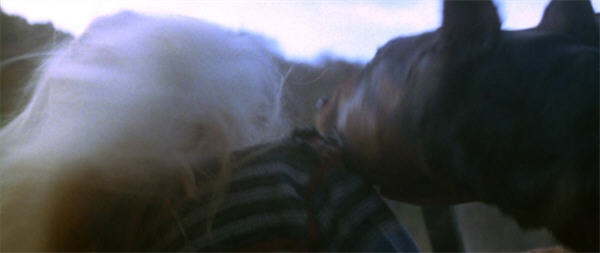
Marc learns of Kim’s survival via the news. He does not blame his dog, but does realise that if he wants the job finished, he’ll have to do it himself.
(Mind you, the lesson he should have learned from this is that if you want something done right, send a cat.)
The hospital is one of this film’s more credible touches, small enough for the district it services, yet big enough that an elderly man in a wheelchair is not recognised as a stranger, nor perceived as out of place. (We note that San Cecilia County has about twenty times the staff of the much larger Haddonfield Memorial…and don’t get me started on High Hopes!) Marc prowls the corridors, searching for his wife’s room. When he finds her, he removes her oxygen line, and breaks the drip of her blood transfusion. The blood runs out of the tubing, down her arm, and onto the figurine still clutched in her hand… And once again we are given a distorted POV shot, this time of Marc as he wheels himself out of the room.
Kathy Logan finds Kim and saves the situation, and Martin has her moved to the ICU, where there is constant surveillance. He reports this attempt on her life to Lt Pegler, and the two agree to keep Kim’s survival quiet for the time being.
Meanwhile, the San Cecilia police force has staked out the backroads, trying to herd the car into a road-block. Three cars go in pursuit; two of them end up skidding off the road and rolling down a slope—where they do not erupt in a fire-ball. At this point I can almost imagine cinema-goers (or perhaps more correctly, drive-in attendees) walking out in protest.
Having made a sketch of the figurine, Martin carries it to the local university, to anthropologist Welsey Edwards, played by – WHOO-HOO!! – John Carradine!! Although not an expert, Edwards recognises the figure as Akasa, a Hittite deity associated with violence and revenge. He promises Martin to try and locate someone who can give him more detailed information. As the doctor leaves, Edwards contemplates the sketch…
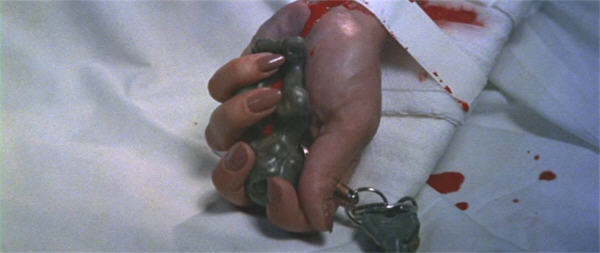
…and we cut to Kim, moaning and thrashing in her hospital bed. Suddenly, she sits up—gazing at the figurine of Akasa with fiery red eyes…
(Not since John Agar’s silver lenses in The Brain From Planet Arous has a pair of contacts made me wince so much in sympathetic pain.)
There is a zoom-in to the red stone in the figurine’s forehead, and then a cut to the distorted POV, as Akasa gazes back at Kim. Abruptly, she tosses her keys across the room, where the evidently magnetised Akasa sticks to the metal handles of a wheelchair. The chair suddenly comes to life, slamming around the room and into the various medical equipment, until Kim reaches out her hand. Akasa flies back into Kim’s grasp, and she lies back again against her pillows.
The damage done to Kim’s room is yet another mystery, although she herself seems fine. In fact, she wakes up immediately afterwards and displays a degree of recovery that surprises her attendants—except that she has no memory of who she is or how she ended up in hospital. Nor does she know why she would have been holding onto the figurine so desperately, but she supposes it’s some sort of good-luck charm…
Kim is well enough to be discharged, but with her amnesia persisting and her life still presumably in danger, Kathy Logan invites her home; something confided to Pegler, but which is otherwise to be kept a secret.
The car is still cruising around, but now the police have set-up a road-block. Three police cars and their drivers have set up a barrier—but not one that succeeds in stopping the car, which slams between two of the cars which – IT’S ABOUT TIME!! – erupt into a fire-ball; the third car goes in pursuit.

Edwards contacts Martin and tells him that he has located someone who might be able to tell him about Akasa, but who wants to see the figurine for himself. Martin reports this to Kim, asking her permission to take the object to the expert.
Aaaaand then it’s time for padding; padding even more egregious than the re-use of the car sequences, as a bickering middle-aged couple get lost in the back-roads. Their wanderings happen to cross the path of the police car’s pursuit of the convertible, which is just too bad for them, although the sequence does not end as we expect. Rather, after a close encounter with the convertible, their car stalls at the base of a sharp drop-off…
Up on the main road, the convertible and the police car encounter a stretch of road-works. The convertible swerves around it, only side-swiping another pulled-up car, but the police car is forced into a bigger swerve around a dump-truck, which sends it flying off the side of the road, through a billboard, down a slope, across the countryside—and off the edge of the drop-off, where it crushes the bickering couple to death in what I can only call a real 70s moment…
Martin carries Kim’s keys and the figurine to the home of Edwards’ expert—a certain Marc Denne. The latter confirms Edwards’ preliminary assessment of the figurine, although he stresses that “passion” and “sexual vigour” were associated with Akasa, rather than war, violence and revenge, as highlighted by Edwards; adding that the piece is very valuable—or will be once the coating in which someone has all but hidden it is peeled away. Having revealed the object within, Denne sounds Martin on his intentions, and so hears the story of the amnesiac patient at San Cecilia County—and learns that she survived an attempt upon her life.
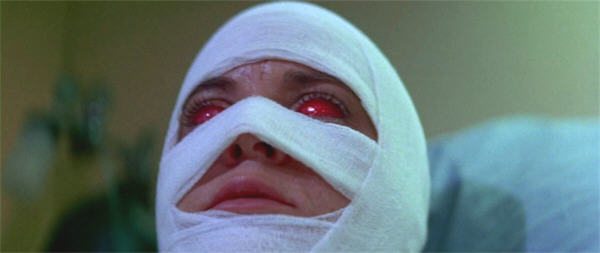
Denne tries to gain possession of the figurine and, when Martin baulks, suggests that he call his patient and ask her; taking advantage of the moment to note what phone number she can be reached at. Called to the phone at Kathy’s, Kim willingly gives permission. She does not react to Martin’s mention of the expert’s name…
As Martin drives away, Denne attaches Akasa to the metal frame of his wheelchair. We then get a distorted vision of Kim as her normal self, one of Denne, and another of red-eyed Kim thrashing in her hospital bed. This Akasa-Vision sequence includes the figurine’s surroundings and a glimpse of Martin driving away; and when it clears we find ourselves in Denne’s bedroom, crutches resting against the wall near to where he lies asleep, and the dog lying on the floor. The latter suddenly leaps to its feet and begins yelping, and a moment later the Akasa-powered wheelchair bursts through the room’s closed door and viciously attacks the animal.
Well. You guys know how I feel about scenes of animal violence, but this one is (thankfully) so unconvincingly staged that even I can’t get upset about it, though it has dismal doggy howling dubbed over it and ends in the dog’s demise. The wheelchair then turns its attention to Denne, who saves himself by managing to detach Akasa from the chair with a well-aimed blow from a crutch.
(I might mention at this pertinent moment that one of the other films I considered for this Roundtable was The Changeling. Evidently something about the topic said “possessed wheelchairs” to me.)
During these attacks, we have had Akasa-Vision glimpses of Kim, back in red-eye mode and thrashing back and forth more or less in rhythm with the blows delivered by the chair. The noise brings Kathy, who recoils with a scream at the sight of her; she rushes to the phone and summons Martin, but by the time he arrives Kim is sleeping peacefully.
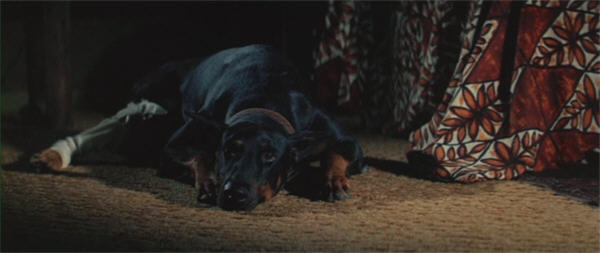
The next morning we catch up with the car again; and during the next series of punctuating cutaways we enjoy some of Crash!’s most impressive (and, yes, insanely dangerous) stunt-work, with a variety of multi-car chases, pile-ups and crashes; plus, of course, a few more erupting fire-balls.
(I haven’t seen this many police cars totalled since The Thing With Two Heads!)
Over breakfast, Martin dissuades Kim from her desire to accompany him on a visit to Denne, encouraging her to focus on her appointment with Dr Cross instead. Kim admits that she hopes no clue to her past is found: that she feels more secure with her past wiped away. As they talk, Kim suddenly remembers a dream she had the night before, in which a dog attacked her—and she saved herself by battering it to death…
Assuming that this was a distorted memory of the original accident, Martin reports Kim’s “dream” to Pegler, who tells him a wrecked car has been found and is being towed. One of several continuity bloopers occurs here, with Martin telling Pegler he has Kim’s keys before his meeting with Denne, who tells him apologetically that he hasn’t been able to find out anything about a prospective owner; and indeed suspects that the coating of the figurine led to its being thrown away, its value unrecognised. Denne offers to buy the artefact, but Martin tells him that he’s sure it’s not for sale; saying enough to prompt a wry observation from Denne that he seems to be taking more than just a professional interest in his patient…
Kathy goes out to do some shopping, and in her absence Denne phones the house, boldly announcing his name to Kim. When she fails to react he spins her a complicated story that ends with her agreeing to let him pick her up, supposedly to meet with Martin at his house in the hills. Once there, Kim’s politeness recoils upon her, as Denne begins to speak bitterly of how his wife hated the house and everything in it – himself included – even though she had “everything a woman could want”—even a sauna.


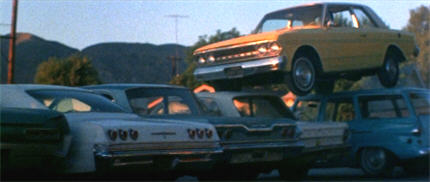
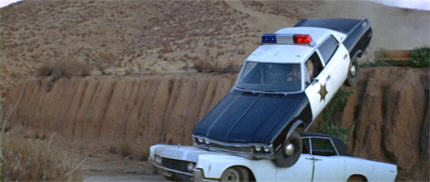
Kim continues to do herself no favours by speaking candidly of her sense that her past wasn’t a happy one, and how she isn’t over-eager to regain her memory; that in fact she suspects she’s happier at the moment than she’s ever been.
Denne, of course, immediately puts two and two together and gets five, inferring a love affair between Kim and Martin, and is not in the least persuaded otherwise by her bewildered reaction. She is also offended by the personal turn the conversation has taken, and tries to leave—only for Denne to block her way with his chair. He has already addressed her in passing as “Kim”; now he throws the whole truth at her:
Denne: “It was my dog – my dog! – that bit you in the face!”
And so saying, he shoves her backwards into the sauna—which we add to the long, long list of cinematic WTF!? designs when it is revealed as having a lock on the outside.
At the impound lot, a tow-truck arrives pulling a damaged black convertible. Martin hands Kim’s keys to Pegler, who demonstrates that, yes, this is the car belonging to the unknown patient—
—only for the car to turn over its engine, put itself in gear and accelerate away—
—and for every single car-crash sequence in the film to play over again…this time around with the image tinted, and occasionally in slow motion; the repeats being periodically interrupted by red-eye Kim jerking around in the sauna.
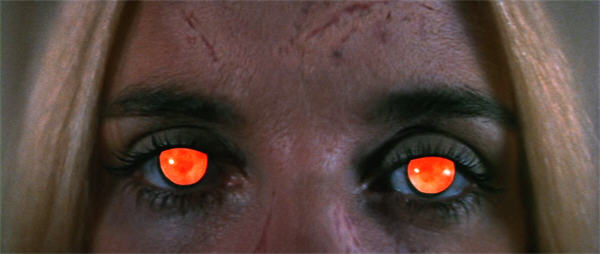
Honestly…it takes a certain kind of chutzpah to pad out a film so shamelessly, and at the same time with such disregard for narrative coherence. I may say that I was utterly confused when the tow-truck turned up with the convertible—last seen causing the blowing up of a garage before speeding off. When it dawned on me that about 50% of the film I’d been watching hadn’t actually happened yet—that it is only now that the convertible begins its destructive journey towards San Cecilia, as marked by the constant mile-signs—my indignation knew no bounds.
Furthermore, the editing of Crash! constantly links Kim and Akasa in a way which, like the driverless car scenes, is not only an outrageous cheat, but manages to obscure the critical point that it is only after Denne’s attempt on Kim’s life, when the blood from her drip runs over the artefact, that all of the supernatural doings begin. But the film pushes this connection so hard from the outset – it opens with a fade from a flash-forward glimpse of the car to Kim before she has even bought the artefact – that it is entirely possible to miss this detail altogether.
The film’s confusing construction also makes it impossible to decide whether Kim is ultimately responsible for Akasa’s actions, or whether the vengeance-loving deity is controlling and using her. If Kim is ultimately directing matters, it does not appear to be a conscious choice on her part; nor does the Kim we get to know seem like the vengeful type. Yet she must have recognised the dog that attacked her, and on some level know who has made the attempts upon her life, even if in her amnesiac state she doesn’t remember. There’s also the possibility that Denne’s opening condemnation of his wife, though coming from a place of bitterness and jealousy, wasn’t entirely unjust. Perhaps Kim is just a victim, or perhaps Akasa is doing her unconscious bidding. We just don’t know.
(And yes, I’m quite sure I’m putting more thought into this than the film-makers did.)
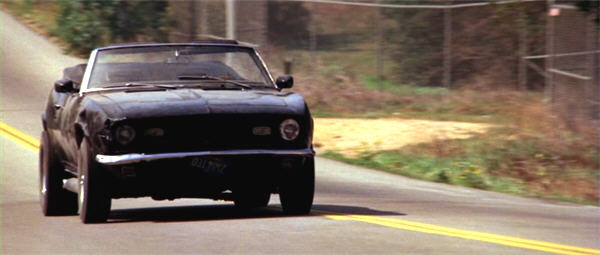
But be all that as it may— It is in the wake of Kim’s first attack of red-eye in the sauna that the car drives away from the impound lot—speeding towards San Cecilia in response, it very belatedly appears, to her “summons”.
But before the convertible drove itself away, a uniform reported to Pegler that his running of the plates identified the car’s owner as a Kim Denne: an announcement that sent Martin speeding towards the house in the hills.
Meanwhile, the car causes some fresh vehicular mayhem – that’s something, I suppose – before pulling into the Dennes’ courtyard. Inside the house, Marc is rehearsing the speech that he intends to give the police upon finding his newly recovered wife dead in the sauna the following morning, when he hears an engine revving. Immediately he confronts the vehicle, armed with a shotgun…
I’ve referenced The Car when discussing Crash!, but while there is a strong resemblance between those two films, the sequence that follows serves to remind us of the daddy of all “possessed vehicle” films, Duel…which is shot like something supernatural is going on, whether or not it actually is, and certainly inspired these two car films, among others.
Thus, while Denne and the convertible are facing off, the latter utters distinct growling sounds as it revs its engine and changes gear, circling Denne and charging him, while he holds it off with shotgun blasts. At last he thinks he sees an avenue of escape and seizes it, but only ends up in his chair on the edge of a drop-away; and when the car follows, he’s trapped.
The car creeps up and pushes man and chair alike over the edge, leaving Denne sprawled on the ground below. There are a few moments’ pause, as the car seems to contemplate its next move—and then it hurls itself over the edge, landing on top of Marc Denne.
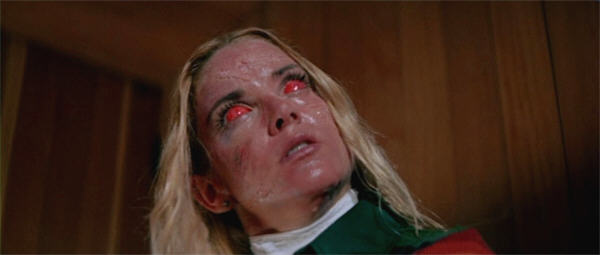
And then it erupts in a fire-ball.
Of course.
Meanwhile, Martin is rushing through the house calling frantically for Kim, and finally discovers her in the sauna—and gets a good look at her in red-eye mode. This fades away, however, as soon as her husband has met his squished-and-’sploded fate…
As long as you can deal with its padding-cum-cheating and its mish-mash of elements, Crash! is a lot of stupid fun. Surprisingly, the film is quite technically proficient—in some areas, a great deal more. It is inevitable that we speak of the stunt-work first, with a shout-out to driver / arranger Von Deming, who had control of the convertible and spent the entire production crammed into a rig in its trunk; while the stunt work is supported by almost alarmingly good pyrotechnics (the latter the work of a gentleman rejoicing, for obvious reasons, in the sobriquet of “Three-Finger Harry”). The other area where this film really excels is its cinematography. For decades Crash! was only available on VHS in pan-and-scan, a situation which does a grave disservice to the efforts of the film’s cinematographer—who was none other than future director, Andrew Davis. Now that it is available on DVD, however, we can see that despite the film being shot fast and cheap, Davis managed any number of interesting composition and lighting effects, and helped to make the production look classier than its pedigree would lead us to expect.
Charles Band’s direction of Crash! is sufficiently competent, albeit focused on the car-crashes and explosions rather than his cast. The acting here is certainly nothing to write home about (except for the Doberman’s), although the professionalism of both José Ferrer and Sue Lyon should be noted. Poor Lyon spends almost the entire film swathed in bandages, covered in makeup scars and/or glowering red-eyed at the camera, but manages to emerge with her dignity intact. Ferrer, meanwhile, if he isn’t exactly exerting himself, does offer a few good moments, and most of the time seems amused by the entire thing. We must, however, commend the courage of his participation in the dangerous courtyard confrontation, where he allowed himself to be circled and rushed by the convertible.
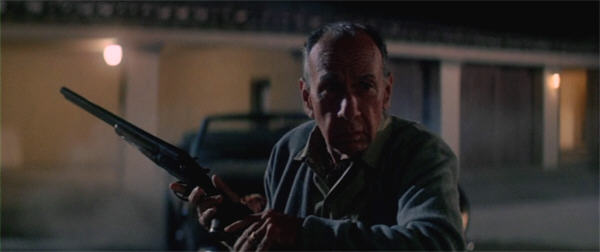
On the other hand, some of the special-effects work here is dodgy, to say the least; the sound recording has a tinny, echo-y quality that makes everyone sound dubbed; continuity errors abound (my favourite? – keep an eye on the nail polish); while the score will either amuse or irritate as it deviates from time to time into that great 70s signifier, wacka-chika-wacka-chika. As for the screenplay, it makes no sense whatsoever; but if details like that bother you, you probably shouldn’t be watching 70s genre films.
At this distance from the film’s production, however, the thing that leaps to the eye is that if Crash! cannot exactly be classified as a killer-doll film, the film may nevertheless have played a part in the germination of the obsession that has fuelled so much of Charles Band’s career.
In fact, it pleases me enormously to imagine that someone reacted to this film by remarking to Charles Band how creepy they found Akasa:
Charles Band: “Creeped out by little figurines, huh? Just imagine if they could move by themselves…”
.
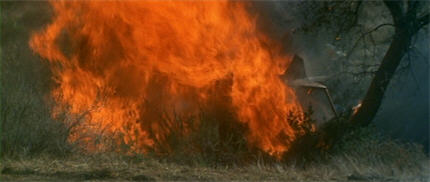
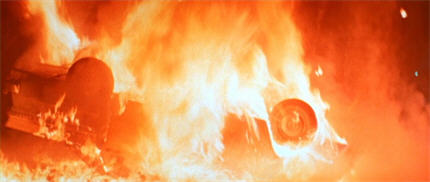
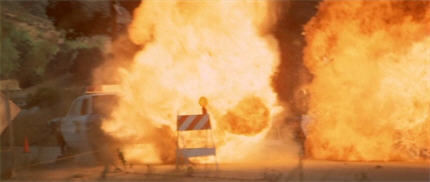
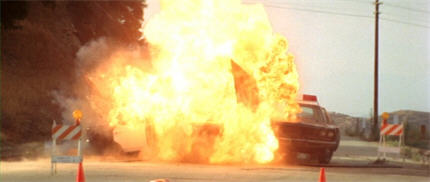
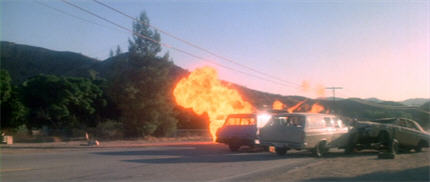
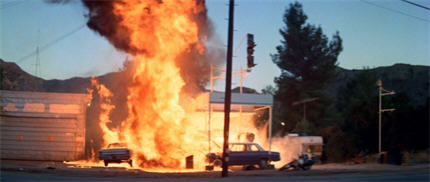
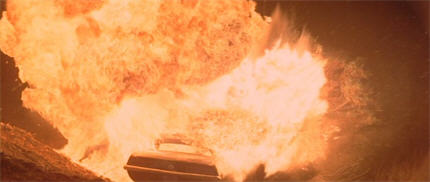
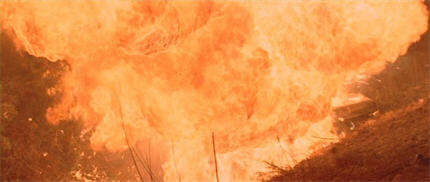
Automobilis americana inflammabilis
********************************************************************************

This review is part of the B-Masters’ attempt to bring some overlooked films into the light.

Thank you for another enjoyable piece! I didn’t know this was a thing until earlier this month, when I was looking up movies with the same title that I didn’t know. It occurs to me that killer car movies are something I’m not really familiar with, aside from the two biggies, Christine and Duel. Sounds like this might be kind of fun.
I love that you recognized the dog. I also love how loudly I laughed at the end. You pulled a perfect Pavlovian bait-and-switch there; no comments all throughout, and then at the end I not only get one, but my favorite of your running jokes. Steven Spielberg would be proud.
LikeLike
You should see The Car if you haven’t. I would also recommend Death Car On The Freeway (speaking of Hal Needham!), which is a bit of made-for-TV insanity. Both of those are more fun than this, although this has its moments in a “whooping-and-hollering while drinking beer” sort of way.
Gotcha! 😀
LikeLiked by 1 person
your comment of the ‘sort of way’ reminds me of a tv show years ago in Phoenix. They would take an old movie and add new dialogue to it. A friend at work said how funny it was. I watched it that weekend, and found it mildly humorous, but not laugh out loud funny. I asked Phil (the friend) if he had watched it, and he said, “Yes, I laughed so hard I almost spilled my beer.’ I thought, ‘that’s the problem. I don’t drink beer, and I watched it sober.’ It can make all the difference.
LikeLike
Yeah, The Car is one I really should get to at some point. Never heard of that other one; may have to look into it.
LikeLike
It’s about a serial killer who does his thing by causing car crashes. 😀
LikeLike
Welp, I’m sold. I’ll have to put it on The List.
LikeLike
That German poster… “Dracula’s Death Race”? But it’s worse than that, when you learn that Death Race 2000 (1975) was released in West Germany as “Frankensteins Todesrennen”!
I know a collie/huntaway cross who fell for the fake ball throw once, when she was very young, and now just gives one a withering look.
LikeLike
We had a miniature schnauzer that didn’t pick it up quite that quickly, but it didn’t take her too much longer. She didn’t give you a glare, though; she’d just turn her head, see no ball, and turn back and look at you expectantly. If she was really on her game, she wouldn’t even have to turn to look. The male never, ever picked up on it in all his years. He was rather dim for a dog, though.
I love the German thing about sticking Frankenstein willy-nilly into movie titles. The five or so Godzilla movies they did that to never fail to amuse.
LikeLike
In this, I can only imagine that “Dracula” was some sort of word-association reference to John Carradine; unless they meant the dog?
Aww, I love miniature schnauzers!
LikeLike
I generally go for big dogs, but the schnauzers won me over pretty quickly. They are great dogs.
LikeLike
Wasn’t David Carradine’s character in DEATH RACE 2000 actually named “Frankenstein”? I’m not saying that isn’t stupid (it is), but the German title makes some sense for a change…
LikeLike
I’m surprised that the Doberman wasn’t part of the ‘supernatural’ part of the story. Usually, it’s an emissary of Satan (if not Satan himself).
The song, “Ruby, don’t take your love to town” was running through my head during this review.
LikeLike
Doing what Marc Denne tells you is sort of like being an emissary of Satan. 🙂
There wasn’t much love being taken anywhere in this, unless that too got lost in the shuffle. I still can’t figure out if there was supposed to be something going on between Kim and Martin. (You could make an equal case for Martin and Kathy.)
LikeLike
NOW I WANT A FILM WHERE A MINIATURE SCHNAUZER IS THE EMISSARY OF SATAN, DAMMIT!!
LikeLike
Maybe that can be my next movie after Ultrapossum vs. Megadillo. I want to name it after one of ours, but I’m not sure Bridget: Satan’s Schnauzer or Devil Dog Ace works.
LikeLike
I think “Satan’s Schnauzer” is perfectly sufficient. 😀
LikeLike
Ah, the wonders of Explodium, cinema’s most glorious building material.
LikeLiked by 1 person
I wonder if Kim and Marc’s May/December marriage wasn’t meant to be an inside joke about Sue Lyon’s most famous role–Lolita.
LikeLike
It’s possible, although that isn’t really the vibe within the film. (Then again, what was intended and what ended up onscreen could well be two different things!)
LikeLiked by 1 person
A Hittite revenge god, a possessed 1968 Camaro (with sidepipes!) and they still didn’t think they had the film primed with enough crazy so they had to bring on the idea of a Doberman as the weapon in an attempt at first degree murder! You gotta respect that. Well, I’ve seen The Car so maybe it’s about time I see this film too. (Since you say the dog death scene is poorly done I think I can manage to get through it with the sound muted)
LikeLike
The crazy is its one great justification.
The dubbed-in yelping is upsetting, but the rest is just silly. Anyway, if I can get through that scene, you can—trust me!
LikeLike
“Band has disowned the earlier Last Foxtrot In Burbank, perhaps understandably.”
I was going to ask if he still claims the soft core musical version of Cinderella that he released in 1977, but I see he was just the producer on that one. I actually think it’s pretty funny, especially the songs and the “Fairy Godmother”.
LikeLike
Every time someone comments on one of these old reviews, I have to go back and read the review all over again. Thanks!
LikeLike